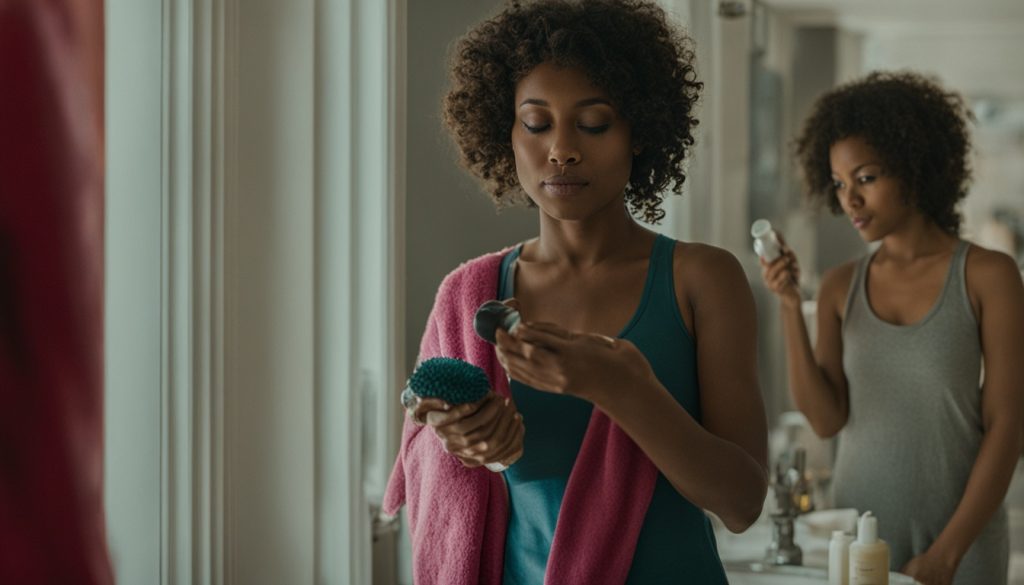Discover the secrets to healthy, glowing hair with this detailed hair care guide. If you’re dealing with dull or lifeless hair, this guide is for you. It’s packed with expert advice to improve your hair’s look.
Learn how to understand your hair type and create a good hair care routine. Master key styling techniques and feed your hair from roots to ends. Get ready to see your hair’s true beauty with this ultimate hair care guide.
Key Takeaways
- Uncover the secrets to identifying your hair type and texture for customized care.
- Discover the must-have hair care essentials for a healthier, more vibrant mane.
- Master the art of shampooing and conditioning for salon-worthy results at home.
- Explore heat-friendly styling techniques to protect your hair from damage.
- Nourish your locks with nutrient-rich hair masks and DIY treatments.
- Banish split ends and maintain hair health with a regular trimming schedule.
- Safeguard your hair from environmental aggressors like sun exposure.
Understanding Your Hair Type
Knowing your hair type is key to getting healthy, shiny hair. Your hair type is based on its natural shape and feel. It can be straight and fine or thick and curly. Finding out your hair type helps you pick the right care routine.
Identifying Your Hair Texture
Hair texture is about how thick or thin each hair strand is. There are four main types:
- Straight hair: Smooth, sleek, and easy to style.
- Wavy hair: Has a gentle wave or bend.
- Curly hair: Can be loose S-shaped curls or tight spiral curls.
- Coily hair: Has tightly coiled, kinky patterns.
Determining Your Hair Porosity
Hair porosity shows how well your hair takes in and holds moisture. Knowing this helps you pick the right products and methods for keeping your hair moisturized. There are three main levels:
- Low porosity: Hair cuticles are closed tightly, making it hard for moisture to get in.
- Normal porosity: Cuticles are just right, letting moisture in easily.
- High porosity: Cuticles are open too much, causing moisture to escape quickly.
Knowing your hair type, texture, and porosity helps you create a hair care plan that fits you perfectly.
Hair Care Routine Essentials
Creating a regular hair care routine is crucial for keeping your hair healthy and shiny. You should pick the right products and methods for your hair type. This way, you can meet your hair’s specific needs and get the look you want.
To make your best hair care routine, follow these key steps:
- Cleansing: Begin with a gentle, sulfate-free shampoo to clean your scalp and hair without drying it out.
- Conditioning: Next, use a moisturizing conditioner to make your hair soft, smooth, and less frizzy.
- Deep Treatment: Add a weekly hair mask or deep conditioning treatment to deeply nourish and fix damaged hair.
- Styling: When styling with hot tools, use heat-protectant products to avoid damage and keep your style going all day.
- Finishing Touches: End your routine with a bit of hair serum or oil for shine, smoothness, and moisture.
For a great hair care routine, pay attention to what your hair needs and change your products and methods as needed. With some trial and sticking to it, you can get the gorgeous, healthy hair you’ve always wanted.

“The secret to healthy, vibrant hair is in the everyday care and attention you give it.”
Shampooing and Conditioning
Proper shampooing and conditioning are key for healthy, vibrant hair. Choosing the right hair products and using them right helps cleanse your hair. It also locks in moisture and makes your hair stronger and easier to manage.
Choosing the Right Products
It’s important to pick the right shampoo and conditioner for your hair type. Whether your hair is dry, oily, colored, or frizzy, there are special formulas for you. Look at the ingredients and choose products that meet your hair’s needs.
Proper Shampooing Techniques
- Start by thoroughly wetting your hair with lukewarm water.
- Apply a small amount of shampoo to your scalp and massage it gently with your fingertips.
- Avoid vigorously scrubbing or over-shampooing, as this can strip your hair of its natural oils.
- Rinse the shampoo thoroughly, ensuring all residue is removed.
- Follow up with a conditioning treatment, applying it from mid-length to the ends of your hair.
- Leave the conditioner on for a few minutes before rinsing it out completely.
By following these best practices, you can get clean, nourished, and manageable hair. Your hair will shine with vitality.

Styling and Heat Protection
Styling your hair lets you express your style in a fun way. But, it’s important to protect your hair from damage. This part talks about heat-friendly hairstyles and techniques. These help you get the look you want without harming your hair.
Heat-Friendly Hairstyles
Some hairstyles handle heat better than others. Think about trying these styles:
- Loose, natural waves: Get this look with a curling iron or wand. Use less heat and go for soft curls.
- Sleek, straight styles: For a smooth look, use a good flat iron. Remember to use heat-protective products and don’t overdo it.
- Topknots and buns: These styles use less heat. They still let you look great.
Always use a heat protection spray or serum before styling with hot tools. This creates a shield between your hair and the heat. It keeps your hair styling looking good and your hair healthy.

“Protecting your hair from heat damage is crucial for maintaining its long-term health and vitality.”
Hair Care Guide: Nourishing Your Locks
Keeping your hair healthy and vibrant takes a full approach. Using hair masks rich in nutrients is a great way to do this. These treatments add vitamins, minerals, and antioxidants to your hair. They help make your hair strong, shiny, and easy to manage.
Nutrient-Rich Hair Masks
Hair masks with natural ingredients like argan oil, shea butter, and aloe vera are amazing for your hair. They deeply moisturize and nourish your hair, making it look and feel better. Using hair masks regularly can make your hair soft, silky, and full of life.
When picking a hair mask, choose one that fits your hair type and needs. For fine, fragile hair, go for a light, protein-rich mask. It will strengthen your hair. For thick, coarse hair, a hydrating, butter-based mask can help control frizz and make your hair easier to manage.
| Hair Mask Ingredient | Benefits |
|---|---|
| Argan Oil | Rich in vitamin E and fatty acids, argan oil helps to nourish, soften, and add shine to hair. |
| Shea Butter | A deeply moisturizing ingredient that seals in hydration and protects hair from environmental stressors. |
| Aloe Vera | Aloe vera’s soothing and hydrating properties make it an excellent choice for repairing dry, damaged hair. |
To get the most from your hair masks, apply them as instructed. Focus on the mid-lengths and ends of your hair. Leave the mask on for the suggested time, then rinse well. You’ll see soft, nourished, and healthier-looking hair.

Banishing Split Ends
Dealing with split ends can be frustrating. But, the solution is simple: regular hair trimming. Cutting your hair often is key to keeping it healthy and preventing split ends.
Regular Trimming Schedule
Experts say trim your hair every 6-8 weeks to fight split ends. This keeps damaged hair away and helps new, healthy hair grow. Staying on top of your trim routine helps reduce split ends and keeps your hair looking great.
When figuring out how often to trim, think about your hair’s type, length, and growth rate. Thicker, coarser hair might need more trims. Fine, delicate hair might need less.
- Aim to get your hair trimmed every 6-8 weeks for optimal split end prevention.
- Adjust your trimming schedule based on your hair’s specific growth and condition.
- Consult with your trusted stylist to determine the right trimming interval for you.
Regular hair trimming helps say goodbye to split ends and hello to smoother hair. Remember, a little snip can make a big difference in your split ends-free hair’s health and beauty.
“Consistent hair trimming is the key to keeping split ends at bay and preserving the overall health of your locks.”
Protecting Your Hair
Your hair is a precious asset that needs the best care. It’s important to protect it from the sun’s harmful UV rays. We’ll talk about how to shield your hair from sun damage. This way, it stays strong, healthy, and vibrant all year.
Shielding from Sun Damage
Too much sun can harm your hair, causing color loss, brittleness, and even making it look old before its time. To keep your hair protection strong, try these tips:
- Wear a wide-brimmed hat or scarf when you’re outside for a long time.
- Apply a leave-in sun damage protection product to your hair.
- Stay in the shade when you can, especially during the hottest part of the day.
- Don’t spend too much time in direct sunlight, especially if your hair is colored or chemically treated.
It’s key to protect your hair from the sun to keep it healthy and full of life. By adding these easy steps to your daily routine, you can ensure your hair looks great no matter the season.
“Safeguarding your hair from the sun’s rays is just as important as protecting your skin. With the right strategies, you can keep your tresses in top condition all year round.”
DIY Hair Care Recipes
Using natural ingredients can change how you care for your hair. Discover easy DIY hair care recipes for your specific hair type. These recipes include nourishing masks and serums you can make at home, saving time and money.
Try using coconut oil, honey, and avocado in your hair care. These ingredients hydrate, strengthen, and add shine to your hair. They help you get the healthy, vibrant hair you want.
Start your DIY hair care journey and discover how to get beautiful, easy-to-manage hair. Improve your hair care by trying these simple yet effective recipes. They let you take charge of your hair’s health, step by step.
FAQ
What are the key steps in an effective hair care routine?
A good hair care routine includes steps like shampooing, conditioning, and using special treatments. It also means protecting your hair from heat and damage.
How do I choose the right shampoo and conditioner for my hair type?
First, figure out your hair’s type, texture, and how it absorbs products. Then, pick shampoos and conditioners made for your specific needs. Whether you need hydration, volume, or color protection, there’s a product out there for you.
What are the benefits of using a hair mask or deep conditioning treatment?
Hair masks and deep conditioning treatments give your hair a lot of nourishment. They make hair stronger, reduce frizz, add shine, and help restore moisture. This leads to healthier, easier-to-manage hair.
How often should I get a haircut or trim?
How often you need haircuts or trims depends on your hair type and length. Generally, trimming your hair every 6-8 weeks helps prevent split ends and keeps your hair healthy.
What can I do to protect my hair from sun damage?
To protect your hair from the sun, use a hat, scarf, or parasol outdoors. You can also apply a leave-in conditioner or styling product with SPF to shield your hair.
What are some easy, DIY hair care recipes I can try at home?
You can make simple hair masks at home with ingredients like avocado, honey, coconut oil, or apple cider vinegar. You can also create your own hair serums or volumizing sprays with natural oils and essential oils.

